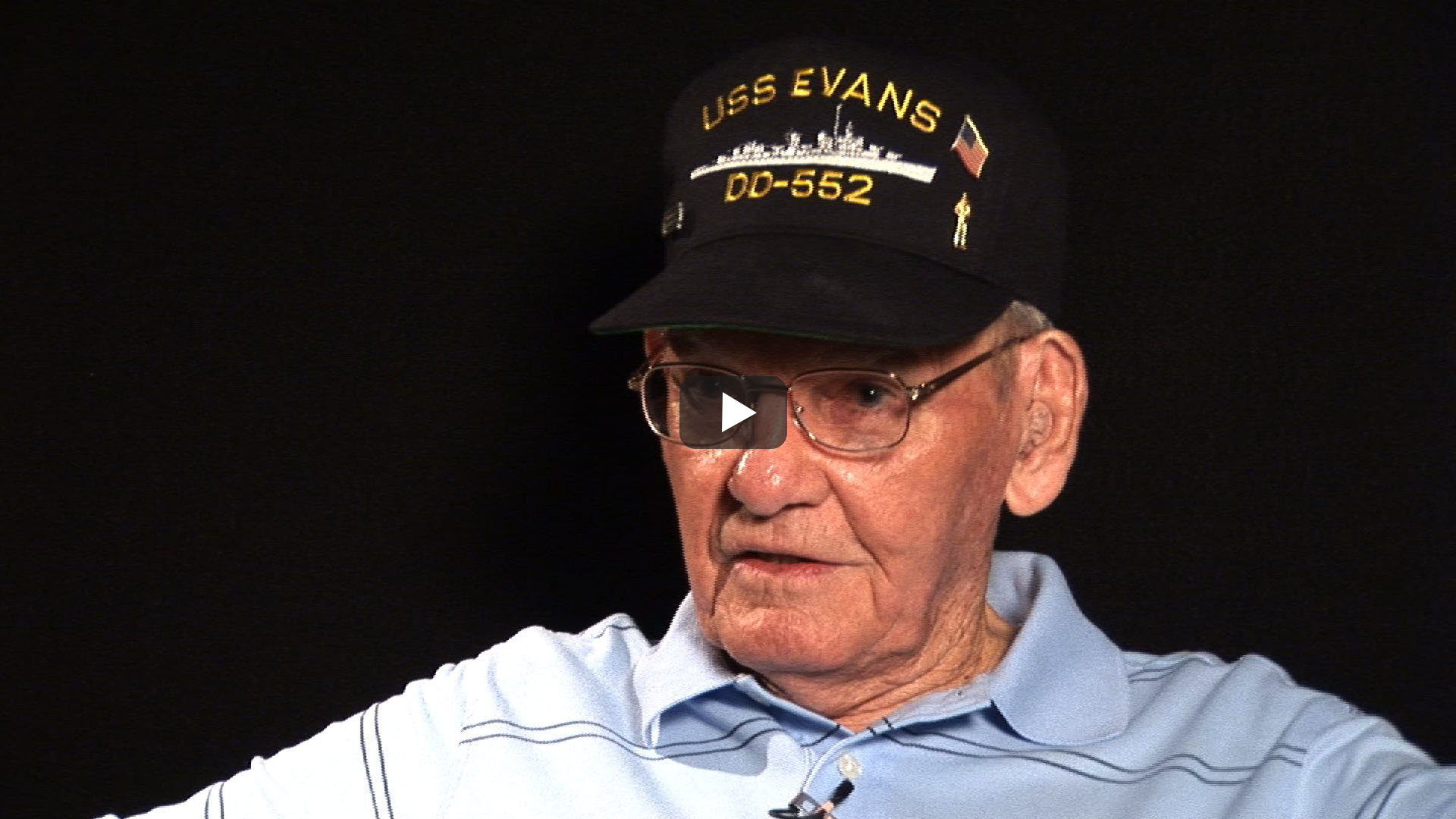15 years • 15 stories
The Museum’s collection of oral histories is one of our proudest assets, an essential part of our foundation, our daily work, and our future. Ours is the story of stories, and of the men and women who wrote history with theirs.
This site is designed to deepen your understanding of these stories, of the Museum’s mission, and of why we are working so hard to strengthen this foundational part of our collections. It is also a hands-on demonstration of the ways in which we are using these collections every day: customizing content, preserving our assets, and bringing historical lessons to life through the words of the men and women who actually lived this history. We hope you’ll enjoy this exclusive online experience!
An inside look at the making of The National WWII Museum's oral histories through eyes of the historians who collect them.
-
Richard Greer
1ST MARINE DIVISION, PTO—GUADALCANALPart of the first wave of Marines onto Guadalcanal, Richard Greer saw heavy combat in his weeks on the island. One of the most pivotal battles during that time was the battle for Henderson Field, which his oral history describes with great detail—including the terrible moment of coming under Japanese attack in that brutal battle.
-
Don Hoff
US NAVY, USS ENTERPRISE (CV-6) SCOUTING SQUADRON 6, PTO—MIDWAYAs a radioman and gunner on an SBD Dauntless dive-bomber, Don Hoff had a memorable view of one of the Pacific Theater’s most pivotal actions: the Battle of Midway. During the battle, American planes were trying (and failing) to locate the Japanese fleet in the vast Pacific waters—a search that seemed increasingly hopeless. Then they spotted the destroyer Arashi.
-
Harold Ward
US NAVY, USS SAN FRANCISCO (CA-38), PTO—PEARL HARBOR, SOLOMON ISLANDSWhen Harold Ward joined the US Navy, few jobs were available to African American sailors. He was given a job in the kitchen and a battle station as sky lookout on the USS San Francisco (CA-38), where he witnessed the first waves of Japanese planes coming into Pearl Harbor. A year later, in the Solomon Islands, Ward witnessed one of the fiercest naval battles ever fought.
-
Ralph E. Crump
US MERCHANT MARINE—TRANSPORT AROUND THE WORLDAs a merchant mariner, Ralph Crump helped transport materiél to US troops around the globe—to Tasmania, Australia, Calcutta, and Alexandria, and more. This year, Crump is helping preserve the legacy of the Greatest Generation and of the US Merchant Marine by sponsoring the new Ralph E. Crump LTJG, USNR, US Merchant Marine Gallery, opening December 2015.
-
Kelly Kuwayama
US ARMY 442ND RCT MEDIC—ETOJapanese American Yeiichi “Kelly” Kuwayama served as a medic with the 442nd Regimental Combat Team. In his oral history, highlighted in the special exhibit From Barbed Wire to Battlefields, he recalls the feeling of fear that accompanied the first moments of combat, and the discipline it took to perform his assigned duties amidst the chaos of battle.
-
Philip Schweitzer
11TH AIRBORNE DIVISION MEDIC, PTO—LOS BAÑOSAlong with other paratroopers of the 511 Parachute Infantry Regiment in the Phillipines, Phillip Schweitzer dropped 25 miles behind enemy lines to help rescue prisoners from the Los Baños prison camp. Schweitzer’s oral history recalls many refusing to leave without first returning to barracks to retrieve keepsakes and mementos. But Schweitzer and the 511th knew there was no time to waste.
-
John Rogers
US ARMY 2ND ARMORED DIVISION, ETO—NORMANDY, BULGE, LIBERATIONTank company commander John Rogers recalls tank battles, sniper attacks, and even friendly fire losses, as well as the interactions that convinced him of the righteousness of the Allied cause—from liberated French citizens cheering the arrival of American tanks to the somber discovery of emaciated prisoners too weak to celebrate their long-awaited liberation.
-
J.J. Witmeyer, Jr.
US ARMY 79TH INFANTRY DIVISION, ETO—NORMANDYJ.J. Witmeyer spent more than 200 days on the front lines of the Norman hedgerow country, and later in life could still remember notable battles blow by blow. But for this soldier, the most meaningful turning point in the war was far more personal.
-
Richard Baile
B-29 FLIGHT ENGINEER, 9TH BOMB GROUP PTO—JAPANESE HOME ISLANDSThe final months of the war the fire-bombing of Tokyo and other Japanese cities. As a flight engineer with the 9th Bomb Group, Dick Baile took part of those dramatic bombings. In his oral history, Baile recalls what it was like to fly over the Japanese mainland, including his role in the infamous March 9, 1945, bombing of Tokyo, and the intensity of the fires wrought by his bomb group on Japan’s capital city.
-
Charlotte Weiss
INTERNED JEW, ETO—AUSCHWITZBorn in Bratislava, New Jersey resident Charlotte Weiss is one of five sisters who were corralled in a ghetto, then carted from one concentration camp to another during the Holocaust. During this time they were imprisoned in multiple camps, including Geislingen (a sub-camp of Natzweiler-Struthof), Allach (a sub-camp of Dachau), and Auschwitz.
-
Raymond Monpat
US NAVY, USS EVANS (DD-552), PTO—SAIPAN, IWO JIMA, OKINAWARaymond “Ray” Monpat served aboard the Navy destroyer USS Robley D. Evans, seeing action in some of the Pacific Theater’s deadliest battles—including Saipan, Iwo Jima, and Okinawa. In the Battle of Okinawa (pictured here), the ship survived bombing, severe flooding, and a fearsome kamikaze attack on May 11, 1945.
-
John Luckadoo
US ARMY EIGHTH AIR FORCE 100TH BOMB GROUP, ETO—ENGLANDJohn “Lucky” Luckadoo was one of the original class of 40 co-pilots assigned to the newly formed 100th Bomb Group. Luckadoo flew with the “Bloody Hundredth” on some of their most harrowing and deadly missions. He completed his 25-mission tour of duty in February 1944, one of only five members of his 40-man class to do so.
-
Bob Liles
23RD FIGHTER GRP, 16TH FIGHTER SQUADRON—CBIStationed in the China-Burma-India Theater, P-40 pilot Bob Liles learned to rely on his Chinese allies for help in nearly everything—from washing laundry to providing an early-warning system to guard against incoming Japanese aircraft. Unfortunately, the warnings didn’t always come in time.
-
Barbara Pathe
RED CROSS, EUROPEOn May 22, 1944, Barbara Pathe volunteered with the American Red Cross with a desire to work overseas. Two months later, she was in Great Britain serving doughnuts and coffee to American troops abroad, working in a Red Cross “Clubmobile”—a converted truck outfitted with a doughnut maker and coffee machine.
-
Roy S. “Swede” Boreen
USN, USS OKLAHOMA (BB-37), PEARL HARBOROn December 7, 1941, Roy S. “Swede” Boreen woke before 0700, ate breakfast, and reported to the disbursement office—his post on the USS Oklahoma (BB-37) in Hawaii. At 0755 came a call to general quarters. Boreen was on the staircase when he spotted a bomber bearing the Japanese Rising Sun—an enemy plane attacking American ships—bringing World War II to America.
See More of Our Collections
Take a deep dive into more oral histories and an expansive collection of archival photographs in the Digital Collections of The National WWII Museum.
Digital Collections
Explore a special collection of artifacts and oral histories curated through the Dog Tag Experience especially for readers of the 2015 Annual Report.
Use the code 0000081A14 to access your collection.
Dog Tag Experience
View the Museum's channel on YouTube.
YouTube


